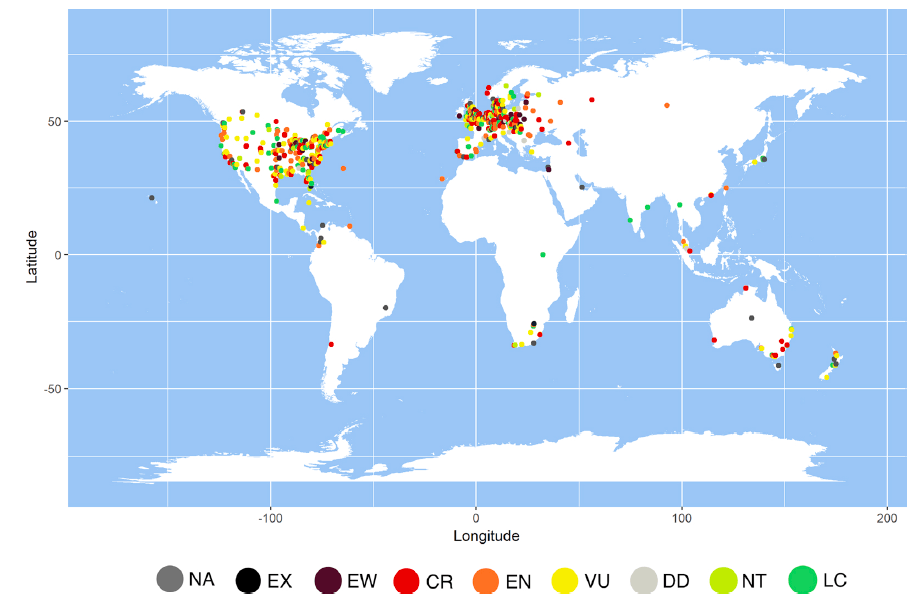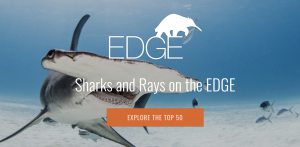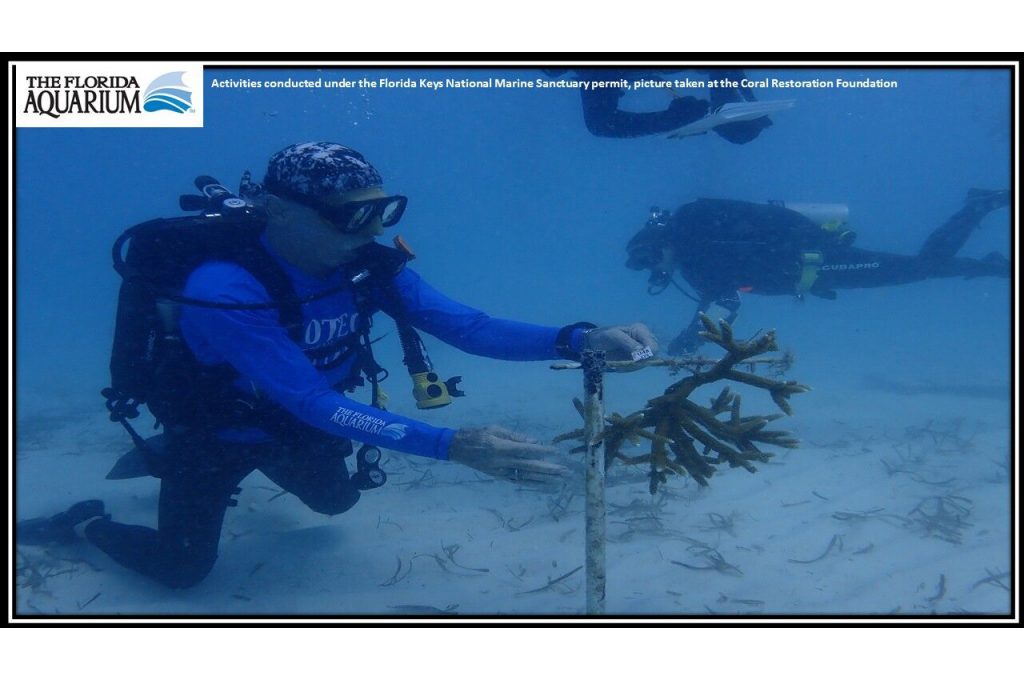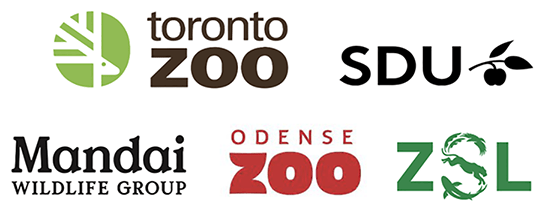The full potential of aquariums to aid and inform conservation of fish and corals runs deep, especially when considered across institutions worldwide. The study by Species360 Conservation Science Alliance and published in Journal for Nature Conservation reports aquariums and zoos hold 21 percent of coral species that are Vulnerable to Climate Change (VCC), Evolutionary Distinct and Globally Endangered (EDGE), and assessed by the IUCN Red List (IUCN).
“This study shows the value in different sets of data combining to highlight where the greatest needs and opportunities lie for us to work together.” – Dr. Kira Mileham, Strategic Partnership Director for the IUCN Species Survival Commission

Looking collectively at 3,370 fish and coral species in 594 aquariums and zoos worldwide, Species360 Conservation Science Alliance and IUCN Species Survival Commission researchers find a full 14 percent of all known fish species can be found within aquarium collections.
“Aquarium populations offer an enormous representation of diversity that makes them uniquely equipped to help develop conservation strategies,” said Dr. Dalia Conde, research author and Director of the Species360 Conservation Science Alliance, and Associate Professor at the University of Southern Denmark.
For species at risk in natural habitats, aquariums can be a lifeline for conservationists who may feel they are fighting a losing battle. “Facing issues of such magnitude as changing climate, ocean acidification and over-fishing requires the conservation community to work together to strategically decide which efforts we must focus on and how to best save species. Experts within the zoo and aquarium community have vital roles to play in the success of these conservation efforts. This study shows the value in different sets of data combining to highlight where the greatest needs and opportunities lie for us to work together,” said Dr. Mileham, Strategic Partnership Director for the IUCN Species Survival Commission.

Aquariums have 21 percent of (17 of 82) coral species listed as evolutionary distinct and vulnerable to climate change.
The role of coral populations is foundational. Coral ecosystems determine marine biodiversity well beyond their immediate reach; 25 percent of marine species can be linked back to reef systems.
“The dramatic declines in coral reefs globally are of grave concern. As the world grapples with how best to respond, the vital conservation roles of aquariums and zoos become increasingly clear. Building and maintaining such biodiversity ‘safe-houses’ provides a backup plan against increasingly extreme and unexpected events, as well as against the declines that growing threats like climate change and habitat loss bring. They also bring us fascinating glimpses into creatures’ lives which we might never have in the wild,” said Professor Wendy Foden, South African National Parks and Chair of the IUCN Species Survival Commission’s Climate Change Specialist Group(IUCN SSC).
Since 2014, a fast-moving disease has killed vast populations of coral in the Florida Reef Tract, according to the Florida Department of Environmental Protection, and the consequences of the loss are economic as well as environmental. Marine activities linked to its coral reefs generate $2.36 billion in sales and income annually. Efforts to rebuild reefs can further benefit from the collaboration of more aquatic institutions worldwide. The Florida Aquarium and MOTE Marine Laboratory are among those leading discovery, breeding, and re-introduction programs central to recovery efforts.

57 percent of affected Florida Tract corals also are housed in aquariums.
“The fate of the Florida Reef Tract is thoroughly dependent on our ability to remove healthy coral, and genetic material from the wild and preserve it by serving as an ark, as well as increasing populations and genetic diversity through land-based breeding programs,” said President and CEO of the Florida Aquarium Roger Germann. “We have been at the forefront of this effort and in early April will plant more than 3,000 new coral fragments raised from larvae into the Florida Reef Tract to contribute to this critical restoration initiative. Aquariums have seen the writing on the wall and are taking action now.”
“From this study, we were able to identify that more than half of the coral species dying off the coast of Florida are in aquariums. These populations can provide critical knowledge and hope for re-introductions when the threats are controlled,” said research author Rita da Silva, research fellow ofthe Species360 Conservation Science Alliance and PhD student at the University of Southern Denmark.
OPEN DATA Research: This study conducted with help of partners the World Association of Zoos and Aquariums (WAZA), Wildlife Reserves Singapore (WRS), and Copenhagen Zoo, and is part of a shared commitment to make research data and analysis available to the global scientific community. Researchers from Species360 Conservation Science Alliance, IUCN Species Survival Commission (IUCN SSC), the Interdisciplinary Center for Population Dynamics at the University of Southern Denmark, University of Stellenbosch, and the Zoological Society of London, conducted the research by analyzing data aggregated across global sources VCC, EDGE, AZE, CITES, IUCN Red List, and ZIMS. Download the open access paper PDF here. Download the OPEN DATA for the study here.

EDGE of Existence program highlights and seeks to protect our most unique species.
Bleaching marks half of Great Barrier Reef coral
In the last three years, half of the Great Barrier Reef in Australia has been bleached. Scientists hope that colonies exhibiting resilience in the wild may rebound, and that extant populations may help to sustain the diversity and traits that will encourage survival given the high temperatures as climate change persists.
Of equal importance, say the study authors, are the 106 species of Anthozoa (corals and anemones) and the 1,249 species of fish for which their extinction risk has not yet been assessed by the IUCN Red List of Threatened SpeciesTM. Information held by aquariums can help support both the development of Red List assessments and conservation actions, especially because among these species, scientists fear, are vast populations facing unanticipated crisis.

“Because aquariums in the study share real-time data about species in their care, it is possible to identify whether there are back-up populations to aid conservation. When species are in crisis, such as those affected by the disease outbreak in Florida’s coral reef, having access to current, accurate information is critical to global efforts,” said Dr. Conde.
Of particular interest, adds Dr. Conde, is supporting the decision-making processes of aquariums and research centers by identifying vulnerable species that remain unrepresented in ex situ populations.
“Aquariums and research centers vastly improve what we know about marine life when they share discoveries regarding the unique populations in their care. As they expand their work with threatened species, the collective insight of aquatics professionals becomes increasingly more important to global conservation,” said Meredith Knott, Product Owner, Aquatics and Husbandry at Species360, and Member of the IUCN-SSC Otter Specialist Group.
Nearly 1,200 aquarium, zoo, and wildlife centers in 96 countries are Species360 members. Together, these institutions curate the world’s largest set of ex-situ species data using the Zoological Information Management System (ZIMS).

The Florida Aquarium, a Species360 member institution, is leading several coral conservation, breeding, and reintroduction programs.
About the Study
The paper has been published in the Journal of Nature Conservation and was led by Dalia A. Conde, Director of the Species360 Conservation Science Alliance and Rita da Silva, Research Fellow of Species360 Conservation Science Alliance and PhD Student from the Department of Biology and the Interdisciplinary Centre on Population Dynamics (CPop) at the University of Southern Denmark. Authors include: Wendy Foden, Global Change Biology Group, Department of Botany and Zoology, University of Stellenbosch, South Africa, South African National Parks, and Chair of the IUCN-SSC Climate Change Specialist Group; Paul Pearce-Kelly, Senior Curator of Ectotherms, Zoological Society of London, and Member of IUCN-SSC Climate Change and Conservation Planning Specialist Group; Meredith Knott, Product Owner, Aquatics and Husbandry at Species360, and Member of the IUCN-SSC Otter Specialist Group; and Brian Zimmerman, Chief Curator at Zoological Society of London (ZSL).
Data from the study is available at Species360 Conservation Science Alliance Open Data, and the original paper is open access and can be downloaded here.
Media Contact: Mary Ellen Amodeo / Mary.Ellen@Species360.org









